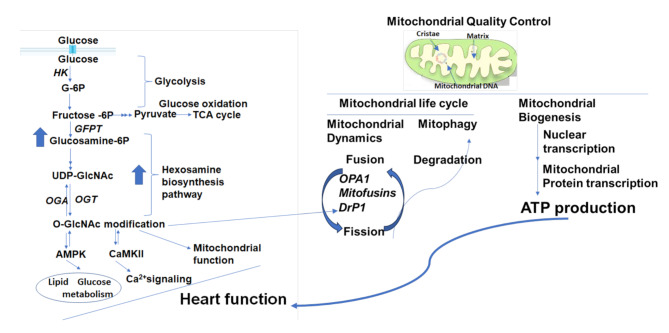Fig. 2.
A: Hexosamine biosynthesis pathway and cardiac function. In cardiomyocytes, glucose is first converted to glucose-6-phosphate (G-6P) by hexokinase (HK). The glycolytic intermediates go through glycolysis to produce pyruvate and are fed into the mitochondrial tricarboxylic acid (TCA) cycle for glucose oxidation. In addition, glycolytic intermediates can also enter various biosynthesis pathways, such as the hexosamine synthesis pathway (HBP). The end product of this is pathway is uridine diphosphate-GlcNAc (UDP-GlcNAc), which is produced by the activity of L-glutamine-D-fructose-6-phosphate aminotransferase (GFAT). UDP-GlcNAc integrates multiple metabolic pathways to provide a feedback on overall cellular energy levels and the metabolism of fatty acids, glucose, nitrogen, and nucleotides. In addition, UDP-GlcNAc can also be used as a substrate by O-GlcNAc transferase (OGT) to add the sugar moiety into proteins. The sugar moieties are removed by O-GlcNAcase (OGA). Different stresses can increase or decrease O-GlcNAc levels, thereby affecting cardiomyocyte function. Mechanistically, AMP-activated protein kinase (AMPK) and calmodulin-dependent protein kinase II (CaMKII) are known to regulate OGT, and both in turn are regulated by OGT. Moreover, AMPK directly regulates glucose and fatty acid metabolism, and CaMKII is involved in cellular Ca2+ signaling. Therefore, O-GlcNAcylation regulates cardiac function by modulating transcription, metabolism, mitochondrial function, protein quality control, and calcium handling. B: Mechanisms of mitochondria quality control. Mitochondria are double-membraned organelles with cristae formation. Mitochondrial quality control is modulated through biogenesis, and mitochondrial dynamics through fusion, which forms elongated mitochondrial networks, and fission, which creates fragmented mitochondria. Optic atrophy 1 (OPA1) is a mitochondrial fusion protein connecting the inner mitochondrial membranes with a special role in cristae shaping/integrity. The dynamin-related protein-1 (Drp1) executes outer membrane division. Mitochondria can accumulate oxidative damage due to various stresses, resulting in fragmentation. The fission process enables the fragmentation of damaged mitochondria to be degraded via mitophagy. Interestingly, Drp1 can be modified by O-GlcNAc in cardiomyocytes, linking the HBP pathway to mitochondrial quality control

